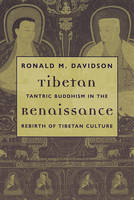
Tibetan Renaissance
Columbia University Press (Verlag)
978-0-231-13471-2 (ISBN)
How did a society on the edge of collapse and dominated by wandering bands of armed men give way to a vibrant Buddhist culture, led by yogins and scholars? Ronald M. Davidson explores how the translation and spread of esoteric Buddhist texts dramatically shaped Tibetan society and led to its rise as the center of Buddhist culture throughout Asia, replacing India as the perceived source of religious ideology and tradition. During the Tibetan Renaissance (950-1200 C.E.), monks and yogins translated an enormous number of Indian Buddhist texts. They employed the evolving literature and practices of esoteric Buddhism as the basis to reconstruct Tibetan religious, cultural, and political institutions. Many translators achieved the de facto status of feudal lords and while not always loyal to their Buddhist vows, these figures helped solidify political power in the hands of religious authorities and began a process that led to the Dalai Lama's theocracy.
Davidson's vivid portraits of the monks, priests, popular preachers, yogins, and aristocratic clans who changed Tibetan society and culture further enhance his perspectives on the tensions and transformations that characterized medieval Tibet.
Ronald M. Davidson is professor of religious studies at Fairfield University. He is the author of Indian Esoteric Buddhism: A Social History of the Tantric Movement (Columbia) and the coeditor (with Steven D. Goodman) of Tibetan Buddhism: Reason and Revelation.
Preface List of Maps, Figures Pronunciation Guide Introduction Chapter 1: Early Medieval India and the Esoteric Rhapsody Chapter 2: The Demise of Dynasty and a Poorly Lit Path Chapter 3: Renaissance and Reformation: The Eastern Vinaya Monks Chapter 4: Translators as the New Aristocracy Chapter 5: Drokmi: The Doyen of Central Tibetan Translators Chapter 6: Treasure Text, the Imperial Legacy Chapter 7: The Late Eleventh Century: From Esoteric Lineages to Clan Temples Chapter 8: The Early Twelfth Century: A Confident Tibetan Buddhism Chapter 9: The Late Twelfth to Early Thirteenth Century: Ethical Crises, International Chapter 10: Conclusion and Epilogue: The Victory of the Clan Structure, Late Tantric Buddhism Notes Glossary Tibetan Orthographic Equivalents Appendix 1: Eastern Vinaya Temples, Cave Temples Appendix 2: Translation and Text of the Root Text of the *Margaphala Appendix 3: A Concordance of Early Commentaries on the Root Text of the *Margaphala Notes to Appendices Notes to the Edition Abbreviations Bibliography Index
| Erscheint lt. Verlag | 21.9.2005 |
|---|---|
| Zusatzinfo | 7 maps, 6 photos, 15 figures |
| Verlagsort | New York |
| Sprache | englisch |
| Maße | 156 x 235 mm |
| Themenwelt | Geisteswissenschaften ► Religion / Theologie ► Buddhismus |
| ISBN-10 | 0-231-13471-1 / 0231134711 |
| ISBN-13 | 978-0-231-13471-2 / 9780231134712 |
| Zustand | Neuware |
| Haben Sie eine Frage zum Produkt? |
aus dem Bereich


